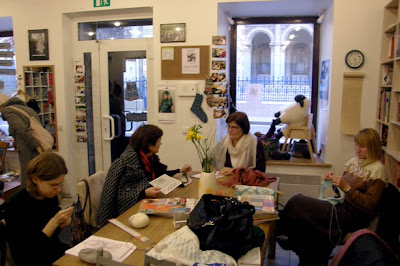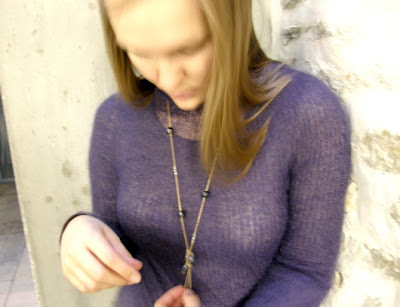Dear readers, first of all, thank you all who showed concern about the "restoration" of the vest. Now I can show you that everything is fine.

Pildid pole eriti õnnestunud, ootan paremat võimalust. Aga kuna sellest vestist võib juba terve romaani kirjutada, siis otsustasin täna näidata n-ö romaani lõppu.
The pictures are not exactly impressive, I am waiting for a better opportunity. However, since one can write a whole novel about the vest, I decided to show the end of the novel, so to say.

Kulus 130 g 4-kordset linast, vardad nr 2. Metraaži ei tea, sest poolidel puudub igasugune info. Toodetakse Biržai linnas, kahjuks pole vabriku kodulehel eriti palju infot.
I used up about 130 g of 4-ply linen, needles no 2. I know nothing about grams/meters because the cones carry no information. The linen is produced in the town of Biržai: unfortunately, the information on the homepage of the factory is not very detailed.
Vesti seikluste tõttu jäi mul kirjutamata Vilniusest, teen seda nüüd. Tuttav pilt, oli parajasti neljapäev ja kudumisklubi koos!
Because of the vest adventures I have not written about Vilnius, so I am doing it now. A familiar view, it was Thursday and the knitting club was there!

Võrreldes suvega on vitriinidesse ilmunud mohäär. Poodides, kus müüakse linaseid kudumeid, on nüüd mohäär. Vaadake palun seda salli ja arvake ära, palju maksab.
Compared to summer, mohair has appeared on the display windows. In the shops that usually carry linen knitwear mohair has arrived. Please have a look at this scarf and try to guess the price.

140 Lt = 40,5 EUR = 635 krooni. Ma ei tea, kas see on palju või vähe. Parempidine kude, suur varras. Aga üks asi on mulle ebaselge, kuidas võib olla 100 % mohäär? Puhast mohääri ei saaks ju kududa, isegi kõige kallimad sordid sisaldavad mingil määral midagi muud. Aga pilt on ilus!
140 Lt = 40,5 EUR = 635 EEK. I don't know whether this is too much or too little. Stockinette and big needles. One thing I cannot understand: how can there be 100 % mohair? It is impossible to knit pure mohair, even the most expensive brands contain something else to some extent. But the picture is nice!

Avastasin veel ühe lõngapoe, õigemini, see on väike kiosk Halės turul. Põhiliselt müüakse seal türgi lõnga ja mingil määral Leedus, põhiliselt Midara vabrikus keritud/pakendatud lõnga (müüja sõnade järgi ei ole see Leedu toodang).
I discovered yet another yarn store, actually, a little kiosk at the Halės turul. Mostly they carry yarns from Turkey and, to some extent, yarns packed in Lithuania at the Midara factory (as the saleswoman told me, these yarns are not produced in Lithuania).

Ja nüüd ajakirjad. Seekord ei olnud mul palju aega ja ma ei ostnud midagi. Aga kuna on ajakirjade vastu huvi, vaatasin, mis mul kodus on, ja teen väikse ülevaate.
And now the magazines. I did not have much time this time and did not buy anything. However, people show interest towards the magazines and so I looked at what I have at home and here is a small review.

Ülemine on "Rankdarbių kraitelė"("Käsitööde korvike"). Seda tõlgitakse ka eesti (nimega "Minu käsitööd"), läti ja vene keelde, nii et eesti lugejad teavad hästi, millest räägin. Viimasel ajal on seal ka välismaa ajakirjadest ümbertrükke. Tehakse ka erinumbreid, nt palmikutest, pitsist jms.
The upper one is "Rankdarbių kraitelė" ("Handicraft basket"). Translations into Estonian (under the heading Minu käistööd), Latvian and Russian, so that my Estonian readers would know what I am talking about. Recently there have appeared reprints from foreign knitting magazines. They do special issues at times, for instance, about cables, lace etc.
"Mezginizi" tähendab "kudumid". Ilmub sarjas Moters savaitgalis ("Naise nädalalõpp"), aga viimasel ajal kuidagi ebareeglipäraselt. Sellest on kahju, sest seal on aeg-ajalt häid mustreid.
"Mezginiai" means "knitted garments" or "knitwear". It appears in the series Moters savaitgalis (Woman's weekend), but in the recent times somewhat irregularly. It's a pity because from time to time there are nice stitch patterns there.
"Mezginių pasaulis" on juba mainitud Midara vabriku ajakiri või õigemini vihk. Kudumid on Midara vabrikus toodetud/pakendatud lõngast. Mul on 2010.a. kevadnumber, kus enamik asju on Angora-2 lõngast. Ärge laske end nimest eksitada, sest angoorat seal pole, koostis on hoopis 50 % mohääri, 30 % akrüüli, 20 % villa, 100 g/750 m.
"Mezginių pasaulis" is a magazine or even a brochure, published by the above-mentioned Midara factory. The garments are from the yarns produced/packed in the factory. I have 2010 Spring issue where almost everything is from Angora-2. Don't be confused by the name because the yarn does not have any angora but 50 % mohair 30 % acrylic, 20 % wool, 100 g/750 m.
"Pačios" ("Ise") on Casa Lana keti brošüür. Neis poodides müüakse enamasti saksa ja itaalia lõngu (BBB, GGH, OnLine jms). On üsna palju pitsimustreid.
"Pačios" (it is difficult to translate into English, something like "Our-, your,- themselves, feminine") is a brochure published by Casa Lana yarn store chain. The stores carry mostly German and Italian yarns (BBB, GGH, OnLine etc). There are quite a bit of lace patterns.











































